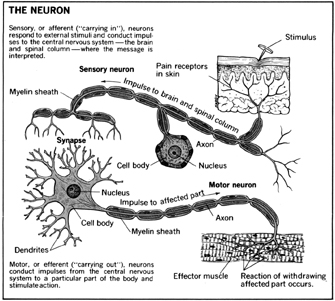The Nervous System and the Brain - The neuron-what nerves are made of
A nerve cell is a grayish blob of tissue from which protrude several short gray fibers, dendrites , and one longer whitish fiber, an axon . Both the dendrites and the axon resemble ropes with their ends splayed and frayed. Dendrites register impulses coming into the central blob of the neuron (perhaps from a neighboring neuron's axon); an axon picks up the incoming impulses and carries them away.
Both units are equally important for normal nerve functioning, but the axon is far more showy as an anatomical structure. All nerve cords are made up of the single strands of many axons, which may reach lengths of several feet. In other words, if we could stretch out certain neurons in our body—for example, those making up the sciatic nerve that runs from the small of the back to the toes—their axon “tails” would make them three or four feet long.
Myelin
A normal axon usually has a fatty coating of insulation called myelin . An axon severed into two pieces cannot grow together again; but if the myelin sheath is pretty much intact, a surgeon can sometimes restore nerve function by sewing the two ends together, or replace the nerve with one from another part of the body. The part of the severed axon connecting to the central portion usually remains alive in any case—which is why a person can often retain the sensation of feeling in an amputated part.
Certain serious and progressively disabling diseases involve the gradual loss ( demyelination ) of this coating, causing paralysis, numbness, or other loss of function in an organ; a demyelinated nerve fiber is not able to carry impulses to and from the brain. Two such diseases are multiple sclerosis and “Lou Gehrig's disease” (amyotrophic lateral sclerosis).
Effects of Aging
Once we reach maturity, the number of our nerve cells begins to decrease, because our bodies cannot manufacture new neurons to replace the ones that die in the normal process of living. (Other kinds of tissue are continually replenished with new cells.) This has some relation to senility, but the loss of a few million out of many billions of brain and nerve cells has little effect on mental powers unless the losses are concentrated in one area.

Synapse, Ganglion, and Plexus
When a nerve impulse, traveling away from the neuron's central part, reaches the ends of an axon, it meets a gap that it must jump to get to the tentaclelike dendrites of the next neuron. This gap is called a synapse .
At certain points in the body a great many nerve cell bodies and branches are packed closely together, with a resulting profusion of interwoven axons, dendrites, and synapses. Such a concentration of nervous tissue is called a ganglion , or plexus . A blow or jolt to such an area can be extremely painful and even stupefying—affecting as it does a whole network of nerves—as anyone who has been hit in the solar plexus or learned the pressure points of karate knows.
The Movement of Impulses along Nerve Fibers
There is really no exact counterpart in the mechanical world for how an impulse moves along a nerve fiber and then jumps across a synapse to the next nerve. Nor is this movement completely understood by scientists. Suffice it to say that it is somewhat like an electrical current moving along in a chemical environment that allows the impulse to travel, in discreet little jumps, at a speed of about 200 miles per hour—quite slowly when we compare it to the speed of light or electricity: 186,000 miles per second. This speed serves us quite well in most situations, but there are times when we wish human beings’ nerves could act more quickly—on the highway, for example, or when a cherished vase starts to topple off the mantelpiece.
One of the simplest and quickest kinds of reactions to an outside stimulus is one that bypasses the brain. We don't really think to pull our hand away from a piping hot radiator. This is called a spinal reflex . What happens is that the sensory nerve endings in the finger pick up the “too hot” impulse from the radiator; the impulse then travels to the spinal cord where it activates the motor nerve pathway back to the burned finger, carrying the message, “Jerk your finger away!”

Comment about this article, ask questions, or add new information about this topic: